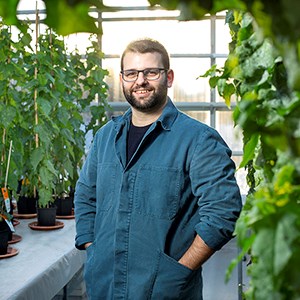The Novo Nordisk Foundation granted your project belatedly because one of the firstly chosen applicants had to reject the grant. How did you feel when you got to know that your project got approved lately?
Stéphane Verger: That was an amazing and completely unexpected news! Overall, this is really a great opportunity for me to strongly boost the research in my lab and in particular kick-start a new branch of my research focusing on the study of wood fibres and mechanical signalling during wood formation.
What do you plan to do with this grant?
Stéphane Verger: There are mainly three parts. First, we will study some of the fundamental biology behind wood formation down to the cellular and sub-cellular level. The goal is to characterize how wood and more specifically wood fibres grow “live”. This is particularly challenging since wood growth takes place very deep within the stem. So, we will develop new methods that will allow us to observe wood growth in “live” samples. We will also mechanically stimulate wood forming tissues and study how they perceive this stimulation and react. In the second part, we want to identify the genes that are responsible for mechanical signal responses during wood formation as well as those controlling wood fibre length and wood mechanical properties. Finally, we will use these genes to generate new trees and study if and how modifications of these genes can improve fibre and wood quality. Providing that we manage to genetically improve wood quality in some of these trees, they might be used later on in forestry but first of all, all trees will serve to better understand wood formation in general.
How does this project connect to your ongoing research?
Stéphane Verger: Since my PhD, I have developed a strong expertise in plant cell and developmental biology as well as plant biomechanics, in particular concerning the question of how cells stick together, called cell-cell adhesion. When starting my independent research group at UPSC, I continued to study cell-cell adhesion in plants and how it may be controlled by mechanical signalling. We are employing highly interdisciplinary approaches combining biology and physics but focus so far on the model species Arabidopsis thaliana which is an herbaceous plant. Now, we want to make use of our expertise and knowledge and transfer it to the tree species aspen, to better understand wood formation.
Why do you think this information is important?
Stéphane Verger: Wood formation is a fascinating developmental process to study, and it is still largely underexplored. I am mainly interested in fundamental discoveries, but I think there is also a major societal need for this research. A large majority of the materials and consumables of our everyday life derive from fossil-based resources, which is not sustainable in many regards. New regulations throughout the world push companies and consumers to switch back to bio-based materials. Recent developments have shown that products from wood and wood fibres could soon substitute almost any fossil-based material but there are environmental concerns regarding the current rate of forest harvesting. We need to find long term solutions that do not compromise ecosystems and ensure a sustainable production of high-yield and also high-quality bio-based raw material.
I think there may be at least two realistic ways to solve this issue: 1) to improve growth rate of trees that make high quality wood but grow slowly, or 2) to improve wood quality of trees that grow fast but have low quality wood. These two properties (growth rate and wood quality) appear to act largely “antagonistic” so far but if we understand how “wood quality” and “wood growth” are controlled, we can maybe start to uncouple these two properties and make wood that grows fast and has high quality. With this project we hope to understand how “wood quality” is regulated and test the effect of modifying this regulation in trees that already grow fast.
What motivated you to become a researcher?
Stéphane Verger: I like biology and to understand how things work. I really didn’t know if I wanted to go into research until my master’s degree, but I did some internships in research labs and I realized that I really enjoyed it! So, I did a PhD, a post doc, and then got very lucky to get the position I have now.
What do you like about working at UPSC?
Stéphane Verger: I really like that we have a lot of shared resources, both in terms of equipment and expertise. I think that was extremely helpful for starting my group. I also like how international it is and that there is a very good and friendly atmosphere in general.
News from Novo Nordisk Foundation about their Research Leader Programme 2021
More information about the Research Leader Programme of Novo Nordisk Foundation
